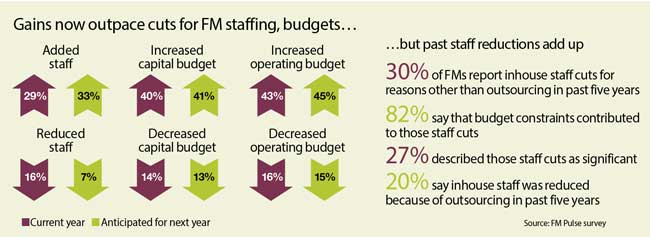FM Organizations Are Smaller, But Are They Understaffed?
The last decade has seen a drop in overall staffing levels in FM departments, but that doesn't necessarily mean those departments are short-staffed.
It’s a Goldilocks question: Are most facilities organizations under-staffed, over-staffed, or just right? Many facility managers and industry experts say they’ve observed a drop in staffing levels within facility departments over the past decade or two. But it’s another matter entirely to say that smaller staffs automatically mean facilities departments are understaffed. (See chart below for the most recent data on staffing and budget levels.)
That dilemma — that a smaller staff isn’t necessarily too small — is one that many facility managers must confront. The fact of the matter is that, even with generally leaner staffing levels, facility managers may find it’s a tall order to justify requests for additional employees.
Budgets and technology
Facility managers aren’t alone in believing, often with good reason, that their departments are understaffed. The underlying forces putting pressure on staff size cut across the entire organization. And there’s really nothing facility managers can do about those underlying trends. “Budgets have become much tighter over the past ten years,” says Stormy Friday, president of The Friday Group.
The effort to trim costs makes it tougher for facilities to compete against other worthwhile budget items in the effort to justify additional expenditures. “We’re always battling for limited resources,” says Robert Robertson, associate superintendent, facility and school services, Klein Independent School District in Klein, Texas.
Because facility managers don’t have any say over the total amount of money in the corporate pot, it’s essential that they make the most of any opportunities to justify the addition of needed staff. But facility managers don’t always get high marks in that regard. Many “facilities organizations have not done an adequate job promoting their staffing needs,” Friday says. For instance, few look at their future business needs, assess their current staffs’ age, skills, and interests, and then develop action plans to fill the gap. To be sure, it’s easy to focus on more urgent responsibilities. However, taking time to engage in strategic planning “isn’t a luxury,” she adds.
If many facilities organizations are smaller, does it follow that they’re understaffed? That’s harder to determine. For starters, ideal staffing levels change due to “the dynamic nature of the industry,” says Christopher Walinski, building operations manager with Munich Reinsurance America, Inc. Even as more efficient tools and procedures reduce the need for staff, new requirements for sustainability or health and wellness targets can boost staffing requirements.
Technology is another factor to consider. For example, touchless restroom systems allow custodians to clean more fixtures in less time. Twenty years ago, conventional thinking held that one custodian could handle about 20,000 square feet within a facility, Robertson says. Now, many custodians can manage 25,000 to 28,000 square feet, he says.
One way to tell if a facilities group is about the right size is to check whether it’s “able to act in line with the overall organization’s mission and values,” says Alana Dunoff, strategic facility planning consultant with AFD Facility Planning. For instance, if the organization has a goal of decreasing its carbon footprint by ten percent over five years, does the facilities organization possess, or can it obtain, the expertise required to help meet this goal?

Related Topics:
















